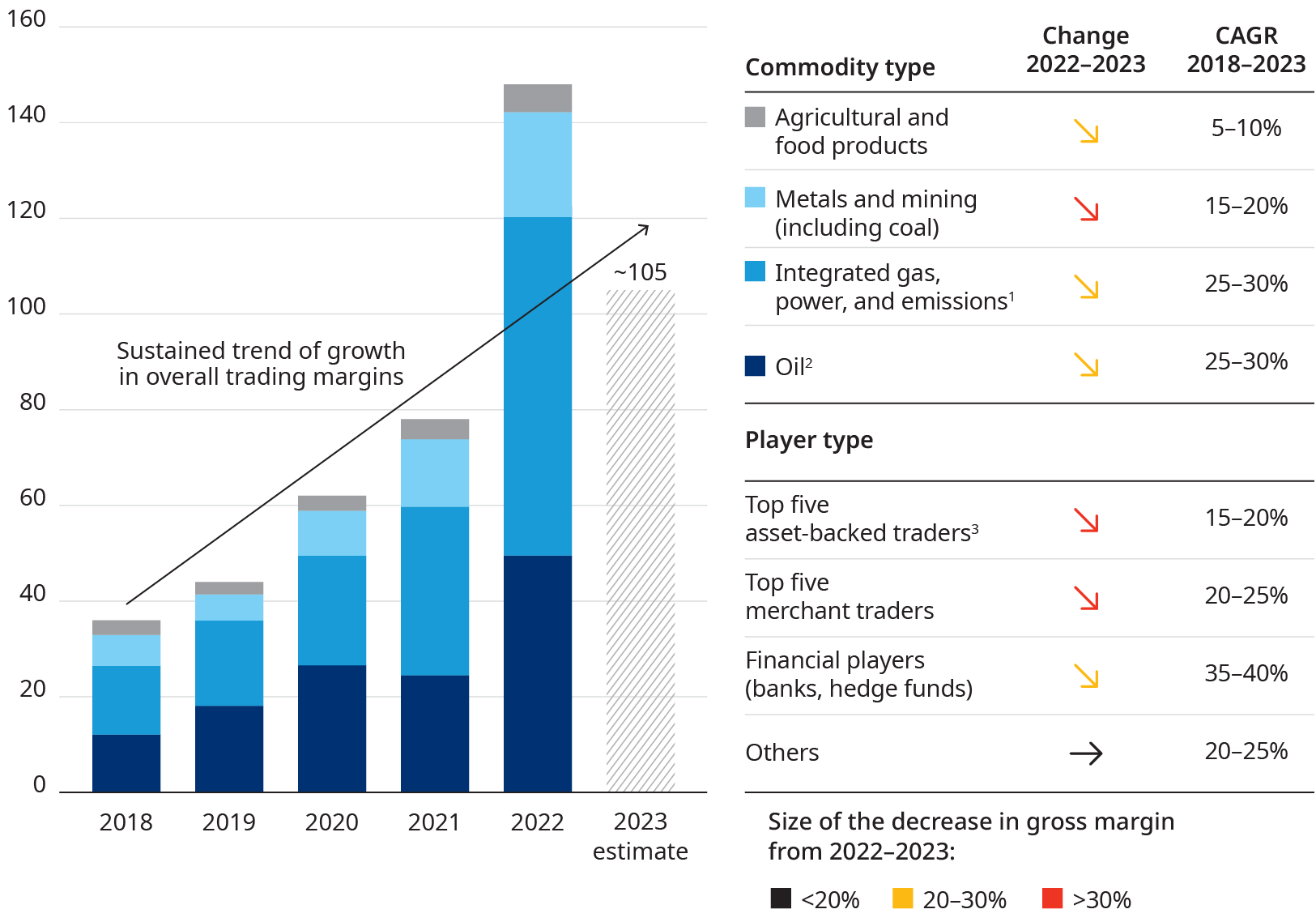For the commodity trading industry, 2023 marked a year of rebalancing. Supply chains, commodity prices, market volatility, and economic growth across regions and sectors began to normalize after the disruptions in 2022. As a result, our analysis shows trading gross margin declined from the 2022 record high of $150 billion to around $100 billion in 2023. Although margin declined, 2023 still ranks as the second-highest level of industry profits, after sustained growth since 2018.
By providing stability to existing supply chains and support for emerging supply chains, traders gained influence in the reconfigured landscape. This position enabled traders to accumulate about $70 billion to $120 billion in cash over successive years of strong performance. With a changing of the guard at the C-suite level across commodity trading firms, those cash reserves provide the opportunity for new management teams to become more impactful long-term investors in the energy ecosystem.

The impactful role is also a high-profile role, and last year traders became more public facing than ever before, operating as trusted counterparties to a wider range of stakeholders than in the past. Traders will need to adapt their culture to accommodate their new role and the expectations it brings. This includes becoming more comfortable with additional scrutiny of their governance and sustainability practices, investing in portfolio-level risk management and steering, changing operating models, and hiring the right talent to fill critical capability gaps.
Commodity trading industry rebalances after record 2022
The decline to around $100 billion of gross trading margin in 2023 indicates two things. First, 2022 was a year dominated by idiosyncratic events, and record margins were not sustainable. But second, the structural factors that drive commodity trading profitability remain in place. Ongoing tightness of supply in major commodities means potential future shocks to commodity markets could cause extreme volatility.
For example, while gross margins for crude trading declined due to lower volatility in 2023, product trading margins were often maintained due to continued inefficiencies and reconfiguration of trading flows (see Exhibit 1).
New executives have significant cash to invest in long-term strategies
The amount of earnings retained by commodity firms in the past five years is likely about $70 billion to $120 billion, according to our analysis. This huge reserve is shifting to the control of a new wave of leaders. Since February 2022, at least 20 senior executives in commodity trading firms have stepped into new positions, including the roles of chief executive officer, chief financial officer, and heads of trading divisions. With significant amounts of cash at their fingertips, the new guard of senior executives must now choose how to invest.
The role of commodity trader is evolving
Not only must new executives decide on which long-term strategic investments to make, they must each navigate a course for their firm to thrive as the sector evolves to a more visible role in commodity markets.
Commodity traders are working more closely with governments to ensure security of energy supply and support new green value chains. By doing so, the job of a trader transitions from a market broker to an investor reshaping supply chains. Yet, while government incentives and the impact of sanctions create opportunities for commodity traders, the changes also impose expectations of new standards of scrutiny.
Traders must invest in assets, capabilities, and culture to thrive
With new leadership and significant cash reserves, commodity trading firms can seize the opportunity to revamp for the future. There are three areas in particular that trading firms should prioritize:
- Strategic asset positions across legacy and emerging value chains
- Widening risk management and steering at the desk and portfolio levels
- A collaborative, tech-enabled trading platform
This year’s paper provides a deep dive into the rebalancing of gross trading margin in 2023, explores the opportunities for new leadership looking beyond short-term market swings by steadily investing in long-term change, and highlights key areas of investment that will allow commodity traders to effectively evolve their roles. This evolution, from market brokers to industry shapers, will be commodity trader’s greatest asset.


